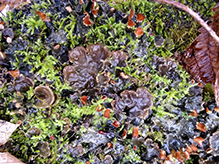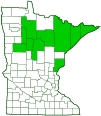Membranous Pelt Lichen
(Peltigera membranacea)
Conservation • Description • Ecology • Distribution • Taxonomy
Conservation Status |
|
|||||||
| IUCN Red List | not listed |
|||||||
| NatureServe | NNR - Unranked |
|||||||
| Minnesota | not listed |
|||||||
Description |
||
Lichens in the genus Peltigera are called pelt lichens or dog lichens. There are 31 Peltigera species in the United States. Nineteen species have been recorded in Minnesota. Identifying them to the species level is often problematic, usually requiring a field guide and sometimes requiring magnification. Membranous Pelt Lichen is a large dog lichen. It occurs in Europe, Asia, and North America. In the United States it occurs in the east from Maine to Massachusetts, west to Minnesota, and south along the Appalachian Mountains to South Carolina. In the west it occurs west of the Rocky Mountains from northern Washington to central California, and south along the Rocky Mountains from Montana to Arizona. In Minnesota it occurs in the northern third of the state. It is found in moderately moist forests and other damp shady areas. It grows on mossy rocks and boulders, on bark at the base of tree trunks or on rotten logs, and on damp soil, including lawns. The vegetative body (thallus) is leaf-like (foliose) and 2″ to 6″ (5 to 15 cm) in diameter. When it first appears, it grows with a roughly circular form. As it ages it disintegrates into irregular groups of elongated and more or less flattened lobes. The lobes are thin, flexible, ⅜″ to ¾″ (1 to 2 cm) wide, up to 1½″ (4 cm) long, and often forked. The tips are rounded or almost straight across, often ascending, and often wavy. The upper surface is wrinkled, with long raised areas separated by narrow channels. It is densely covered with downy or felty hairs when young, but these wear off with age. When wet it is bluish-gray or blackish-green, transparent, and often whitish at the edges. When dry it is gray or bluish-gray to brown and opaque. Isidia and soredia are not produced. The lower surface is white, is densely covered with white hairs, and shows a network of pale raised veins that rejoin after branching (anastomosing). The lobes are attached to the soil at occasional points by scattered anchoring structures (rhizines). The rhizines are long, slender, unbranched, tapered, and white to pale brown. They are covered with short thick hairs (hyphae) that mat together when wet. When dry, the hyphae spread out almost to right angles, giving the rhizine a bottle-brush appearance, but this requires a hand lens to see. The rhizine is said to resemble a dog’s fang tooth. This is the feature that gives the genus one of its common names. Sexual (spore-producing) reproductive structures (apothecia) on the margins of the thallus are frequent. The apothecia are up to ¼″ (6 mm) in diameter, oblong to more or less round, and curved inward, appearing saddle shaped. The disc is flat, smooth, and bright brownish-orange, becoming dark brown to black with age. |
||
Similar Species |
||
Ecology |
||
Substrate |
||
Ground |
||
Growth Form |
||
Foliose |
||
Habitat |
||
Over mosses on rock, bark, and soil |
||
Hosts |
||
|
||
Distribution |
||||
|
Sources |
|||
| 11/17/2022 | ||||
Occurrence |
||||
|
||||
Taxonomy |
|||
| Kingdom | Fungi (Fungi) | ||
| Subkingdom | Dikarya | ||
| Phylum | Ascomycota (Sac Fungi) | ||
| Subphylum | Pezizomycotina (Sac Fungi and Lichens) | ||
| Class | Lecanoromycetes (Common Lichens) | ||
| Subclass | Lecanoromycetidae (Shield Lichens, Sunburst Lichens, Rosette Lichens, and Allies) | ||
Order |
Peltigerales | ||
Suborder |
Peltigerineae | ||
Family |
Peltigeraceae | ||
Subfamily |
Peltigeroideae |
||
Genus |
Peltigera (Pelt Lichens) | ||
| Mycobiont | Peltigera membranacea | ||
| Photobiont | Nostoc | ||
Synonyms |
|||
Peltidea canina var. membranacea Peltigera canina ssp. membranacea Peltigera canina var. membranacea |
|||
Common Names |
|||
Common Dog Lichen Membranous Dog Lichen Membranous Pelt Lichen |
|||
Glossary
Anastomosing
Referring to veins, such as on a plant leaf or a lichen, that branch and rejoin, forming a network.
Apothecium
An open, disk-shaped or cup-shaped, reproductive structure, with spore sacs on the upper surface, that produces spores for the fungal partner of a lichen. Plural: apothecia.
Foliose
Adjective: Leaf-like growth form; referring to lichens with leaf-like growths divided into lobes.
Noun: The leaf-like, vegetative body of a lichen (thallus) that has thin, flat lobes which are free from the substrate.
Hypha
A thread-like cell of a fungus that is the main mode of vegetative growth: the basic structural unit of a multicellular fungus. Plural: hyphae. Collectively, the hyphae of a fungus is the mycelium.
Isidium
An asexual reproductive structure of a lichen in the form of a tiny outgrowth of the upper cortex. It consists of a cluster of algal cells (the photobiont) wrapped in fungal filaments (the mycobiont), and a shiny outer layer of protective tissue (cortex). Plural: isidia.
Phyllidium
An asexual reproductive structure of a lichen in the form of a small scale-like growth on the margins and in the cracks of the thallus. It has dissimilar upper and lower surfaces, contains a green photobiont, and is usually constricted at the base. Plural: Phyllidia.
Rhizine
A root-like structure of a lichen that attaches the lower layer to the substrate.
Soredium
An asexual reproductive structure of a lichen in the form of a tiny dull granule on the thallus surface that can be easily brushed off. It consists of a cluster of algal cells (the photobiont) wrapped in fungal filaments (the mycobiont), but without an outer layer of protective tissue (cortex). Plural: soredia.
Thallus
The vegetative body of a lichen composed of both the alga and the fungus. Plural: thalli.
Visitor Photos |
|||||
Share your photo of this lichen. |
|||||
| This button not working for you? Simply email us at info@MinnesotaSeasons.com. Attach one or more photos and, if you like, a caption. |
|||||
Luciearl |
|||||
 |
|||||
MinnesotaSeasons.com Photos |
|||||
|
|||||

Slideshows |
||

Visitor Videos |
|||
Share your video of this lichen. |
|||
| This button not working for you? Simply email us at info@MinnesotaSeasons.com. Attach a video, a YouTube link, or a cloud storage link. |
|||
Other Videos |
|||
| 'Flowering' Dog Lichens (Peltigera membranacea) Roger Griffith |
|||
About
Sep 13, 2017 The common Dog Lichen (Peltigera membranacea) produces orange 'shield-like' reproductive apothecia in autumn that form from the fungal partner not the alga. Reproduction vegetatively is the norm via small pieces that break off. |
|||

Created: 11/17/2022
Last Updated:


